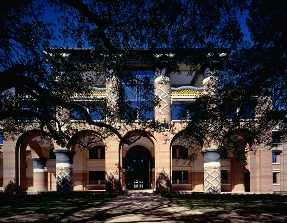 |
Anne and Charles Duncan Hall |
the "unofficial" Duncan Hall web site
|
|
Rice University |
| Houston, Texas, USA |
|
Duncan Hall, the home of Computational Engineering at Rice University,
generates enough interest and enough questions that I put together
this collection of information about it.
This site tries to give you a feeling for the building, for its architect,
John Outram
and for how he approached the task of designing it.
I hope that it dispells some of the rumors surrounding Duncan Hall
and conveys some facts about it that are, so often, misquoted.
Outram has written
a series of essays
about Duncan Hall and the philosophy
that guides his practice.
Just the Facts
Where is Duncan Hall?
The building occupies a prime spot on the Rice University campus.
It is situated north of Lovett Hall, off the University's main
entrance.
To visit,
enter Rice
via entrance one.
When you reach Founder's Court (the lawn in front of Lovett Hall
that terminates the main drive), Duncan Hall is visible to the right.
You will recognize it from
the gray column capitals, the blue rails
and logs, and those amazing yellow balustrades.
Visitor parking is available in the lots on either side of
Founder's Court.
Who Occupies Duncan Hall?
Duncan Hall is one of the flagship buildings of the
George R. Brown School of Engineering
at Rice University. Duncan Hall houses the departments of
Computational and Applied
Mathematics (CAAM),
Computer Science (COMP),
Statistics (STAT), as well as a large portion of the
Department of Electrical
and Computer Engineering (ECE), and
the Ken Kennedy Institute for
Information Technology Institute
It also houses the offices of the
Dean of Engineering.
With roughly fifty faculty and one-hundred fifty graduate
students, Duncan Hall houses a significant fraction of
the faculty and graduate students of the University
When the building opened, it held ten percent of the faculty and
almost ten percent of the graduate sudents.
What About Education?
Duncan Hall houses five classrooms, all clustered around
Martel Hall.
At the north end of the hall are a pair of
seventy-three seat lecture halls.
Two forty-five seat classrooms and a thirty seat classroom
open into the hall.
The Symonds Digital Teaching Center
provides space for multimedia instruction and interaction
in classes of up to forty students.
McMurtry Auditorium, a two-hundred twenty seat room, opens into
Martel Hall.
The combination of the auditorium and hall has allowed Rice
to host numerous professional
meetings that would otherwise have been difficult or impossible to hold.
Just the Rumors
Many, if not most, tours of Rice include a stop at Duncan
Hall.
Something about the building must inspire a creative urge
in the tour guides, because they tell some amazing stories.
We collect these stories, in part for amusement, and in part
to track how far afield they become.
We have posted some of our favorites.
What Was He Thinking?
Any visitor to Duncan Hall notices that it is an unusual
building, in several notable ways. Among Rice buildings,
it stands out for its size, its use of color, and its
cavernous interior.
Reality
These documents try to provide you with a feeling for
the building. Of course, they are no substitute for
walking around the space.
Philosophy
Outram's building is just the realization of a series of
organizing themes and ideas.
To appreciate his building, you can walk through it.
To understand his thought process, you must dive into his ideas.
He has written extensively on the subject; some of his essays
are online. (See
the essays on "Duncanology".)
These pages, derived from the booklet that I wrote for the opening of
Duncan Hall, serve as an introduction to Outram's ideas.
His own writings delve into these ideas in much greater detail
that you will find on this site.
This site is maintained by Keith D. Cooper.
He was the faculty representative on the design team of
Duncan Hall.
He is a terrible e-mail correspondent.
Serious queries about Duncan Hall should be addressed
to the office of the Dean of Engineering, Rice University.

